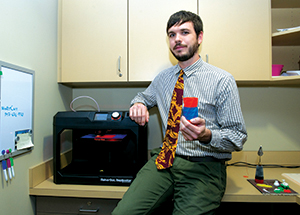University Store’s 3-D Printer: A Swoosh and a Blerp
For such a futuristic piece of technology, the MakerBot 3-D printer sure does make a lot of old-school noises: the swoosh, swoosh, swoosh of an inkjet printer with the occasional bleep, bloop, blerp of Atari’s Q-Bert. But the result? As amazing as the first time you printed a photograph from your computer or jammed down a joystick in your living room.
Now the Pitt community can experience 3-D creation for themselves at the University Store on Fifth.

The hardest part of using a 3-D printer is creating the design, which requires knowledge of CAD or other animation modeling software. Luckily for those who are bewildered by such things, MakerBot has its own network of designs shared by users.
Once a design is selected, the printer heats spools of resin to more than 210 degrees Celsius and repeats layer after thin layer—as small as 0.1 millimeter—onto a platform. The resin is available in a variety of colors, including glow-in-the-dark, and multiple colors can be used within an individual design.
The result? Almost any object you can imagine, as creative as you please, lifted with a little cake server right off the printer platform, already cool enough to handle.
In laboratory and engineering environments, 3-D printers are often used for prototypes. For consumers, however, printers can be used for practical purposes—replacing lost checkers/chess pieces or a little broken bit on a refrigerator. Greg Sciulli, print coordinator at the University Store, says he has already been approached by a student who was looking to make pieces for an original game.
Watching the printer in action is hypnotic and often more of a draw than receiving the finished object. As with the store’s Espresso Book Machine—which prints and binds entire books within minutes— part of the excitement of a personal design is watching it go from digital idea to tangible creation.
Time, however, is a big factor. “One of the big limitations is that prints take a while,” Sciulli says. Like traditional printers, 3-D printers have different resolutions that either speed up or slow down the process. During a celebration of technology near Halloween, Sciulli printed a low-resolution skull that took about six hours to complete. By comparison, a low-resolution ghost (the kind of trinket you’d find in an elementary school goody bag) takes only about 15 minutes.
While 3-D printing technology has been available almost as long as those old gaming consoles, it only recently became financially viable for the general public. The University Store printer is the third printer on campus, although the other two are higher-end and limited to use by the School of Dental Medicine and the Swanson School of Engineering.
The University Store device can accept files from outside sources. Sciulli is also learning design so that he can better assist users. His initial tinkering includes vibrant thumbtack flowers, a funky vase, and a dollhouse-sized table. He’s also working on potential collaboration with the University to make Pitt-themed items such as key chains. For user-designed objects, the University Store says it will offer competitive pricing. Sciulli asks that people have patience as he and his colleagues work out the details of the new technology. “Even if we never sell [our own designs], people can come in just to see it,” says Sciulli. “It’s a really interesting technology.”
Other Stories From This Issue
On the Freedom Road

Follow a group of Pitt students on the Returning to the Roots of Civil Rights bus tour, a nine-day, 2,300-mile journey crisscrossing five states.
Day 1: The Awakening
Day 2: Deep Impressions
Day 3: Music, Montgomery, and More
Day 4: Looking Back, Looking Forward
Day 5: Learning to Remember
Day 6: The Mountaintop
Day 7: Slavery and Beyond
Day 8: Lessons to Bring Home
Day 9: Final Lessons

